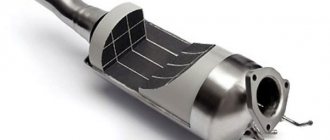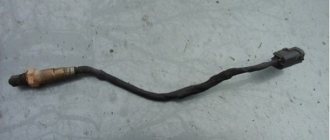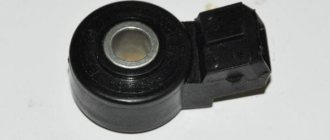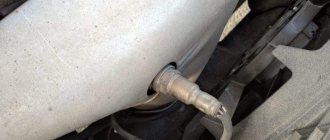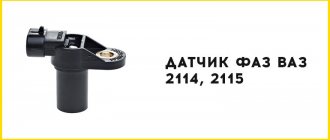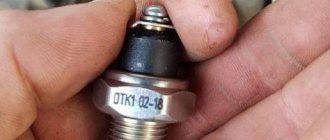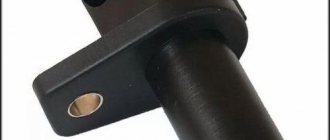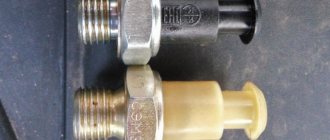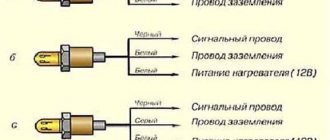The lambda probe or oxygen sensor is designed to monitor the amount of oxygen in the exhaust gases. The excess of air above the mixture is called “enrichment”, and the reverse process is called “leanness”.
Both factors negatively affect the functionality of the motor:
- Power reduction;
- Unstable operation at idle, under load;
- Increased fuel consumption.
In cars of the Lada (VAZ) family, one oxygen controller is preinstalled. European and American models have two built-in sensors: diagnostic and control.
They are similar in appearance, identical in size, but perform different functions.
Operating principle of DC (lambda probe)
The working surface of the sensor is a ceramic material coated with platinum.
The operating temperature of the surface is 350 degrees Celsius and above. Therefore, before heating the lambda probe, during the first 5 minutes after starting the engine, the working mixture is adjusted according to the readings of other sensors in the engine power system. To speed up the heating of the part to operating temperature, an electric heater is installed in it.
The principle of operation is as follows: exhaust gases cover the working surface of the lambda probe, which in turn reacts to the difference in oxygen levels in the exhaust gases and the environment. It then sends a signal to the ECU, which adjusts the fuel mixture.
Where is the oxygen sensor (lambda probe) located?
For 1.5 l engine
The lambda probe (number 11) is installed in the exhaust system on the exhaust pipe. Screwed in from above, in front of the resonator or spacer (if there is no resonator). In other words: put the car in a pit and look throughout the exhaust system for a sensor sticking up. DC is the only sensor that is installed in the exhaust system, so you won’t miss it.
Exhaust system for 1.5l engine
For 1.6L engine
The exhaust system of this engine is slightly different from the 1.5 liter. Pay attention to the figure: In this exhaust system, 2 DCs are planned (at number 2) - both are located on the catalytic collector. These engines are equipped with both 1 and 2 oxygen concentration sensors: Euro-2 toxicity standard - 1 DC, Euro-3 - 2 DC.
Exhaust system for 1.6l engine
Useful video
You can find more information on this topic in the video below:
Experts note that when replacing the sensor, some problems may arise, in particular, the device may stick to the pipe. In this case, you should pour WD-40 on it and try to unscrew it. You can also heat the sensor or lightly tap it with a hammer.
When carrying out work to check and replace the oxygen concentration sensor, you need to be careful, because the sensor is installed on the exhaust pipe of the muffler, which heats up to high temperatures when the engine is running. For safety reasons, wait until the engine cools down.
To carry out the work you will need:
Disconnect the block with wires from the sensor.- We connect the negative terminal of the voltmeter to the engine ground, and the positive terminal to terminal B on the block and turn on the ignition. The voltage must be at least 12 volts. If it is smaller or missing, you need to check the battery charge, the health of the power circuit and the computer.
- After this, we connect the negative terminal of the voltmeter to terminal C and the positive terminal to terminal A. The voltage between them should be 0.45 volts. If the voltage is missing or differs by more than 0.02, then you need to check the power circuit and the computer.
- To remove the sensor, cut the clamp securing the wire to the cooling system hose.
- Using a 22mm wrench, unscrew the sensor from the exhaust pipe and remove it from the car.
- Install the new sensor in reverse order. Secure the wire to the hose with a new clamp. After installation, check that the wire does not touch the exhaust pipe of the muffler.
DK errors
You can detect the presence of these errors by the yellow light on the check engine panel coming on (or it may not light up). You can read these errors either using the on-board computer or using computer diagnostics.
| Error P0130 | Invalid signal DC 1 | ||
| Error P0131 | Low signal level DC 1 | ||
| Error P0132 | Crankshaft sensor 1 signal high | ||
| Error P0133 | Slow response DC 1 | ||
| Error P0134 | No DC 1 signal | ||
| Error P0135 | Faulty heater DC 1 | ||
| Error P0136 | Ground fault DC 2 | ||
| Error P0137 | Low signal level DC 2 | ||
| Error P0138 | High signal level DC 2 | ||
| Error P0140 | Breakage of DK 2 | ||
| Error P0141 | DK 2 heater malfunction | ||
| Error P1102 | Low resistance of DC 2 heater | ||
| Error P1115 | Faulty DC 2 heating circuit | ||
Most often, errors associated with DC appear due to a malfunction of the heating circuit, as a result of which the sensor gives incorrect parameters.
In this case, you need to look for a broken wire or replace the sensor.
Why does the lambda probe die?
We have already clarified above that the service life of the oxygen sensor is 80-160 thousand km. You probably have a question: why is there such a spread in the resource, as much as 80 thousand km? In fact, it depends on the conditions in which the car was operated:
- Bad gasoline, the exhaust of which contains a lot of lead and iron, clogs the sensor electrodes after several fill-ups.
- Poor condition of oil scraper rings and caps. Because of them, oil can get into the mixture, and with it into the exhaust system.
- Due to clamped valves, pops are released into the exhaust system, which destroy the working surface of the sensor.
- Due to an incorrect mixture, ignition timing, as a result of which the sensor overheats, crackling from the high temperature of the converter or catalyst.
Why do you need a catalyst?
Usually, when it comes to a catalyst, most motorists only think of a muffler, or rather a can or pipe. In fact, the exhaust system of a car includes several elements: connecting pipes, muffler, resonator, corrugation, catalyst, etc. So:
- The catalytic converter, as the catalyst is called, is a fairly important element of the car and the entire exhaust system.
- One of the main functions assigned to it is the purification of exhaust gases that flow through the pipe. The latest Euro 2 standards require the presence of a catalyst in the exhaust system of the car and a special oxygen sensor.
- The neutralizer itself, despite the fact that it is made of metal and a massive body, is a rather fragile element. He is afraid of severe mechanical damage, and is also quite sensitive to low-quality fuel. Impurities and various dirt residues contained in low-quality gasoline remain on the walls of the catalyst, gradually accumulate there and lead to damage to the part. In Russian conditions, the catalyst fails very quickly. And if, usually, it is designed for 200,000 km of run, then if it comes into daily contact with Russian fuel, it will not withstand even 30,000 km of run.
How much do ball joints cost for a VAZ 2107 price?
It is useful to know what a catalytic converter is made of. And find out how this part works.
As was said, it reduces the amount of harmful substances and impurities that any car with an internal combustion engine emits into the surrounding atmosphere. These are substances dangerous to human health, such as carbon monoxide, nitrogen oxide, etc.
For example, carbon monoxide is a real gas that has neither color nor odor. But it is precisely this that contributes to the appearance of cardiac colic and headaches in people.
As for the design of the catalyst, it consists of a ceramic or often metal honeycomb part. Why honeycombs?
Yes, because the design resembles a honeycomb. On top of these same honeycombs, special precious metals, most often platinum, are sprayed.
Although palladium catalysts are often used in the automotive industry of developed countries.
Repair and replacement of the neutralizer
Replacing the catalyst in a VAZ 2115 is carried out only after analyzing the peculiar sounds emitted by the exhaust system. It may also be an unusual smell or color of the exhaust gas.
Common symptoms of a faulty catalytic converter include a rattling sound, like scraping metal, coming from underneath the car.
In such cases, it is urgently necessary to replace it with a new catalytic converter or a homemade flame arrester, which copes well with the basic functions of the factory catalyst.
The right tool
For work we will need a set of tools:
Attention: The inspection hole is a mandatory element of the work process, onto which the car should be raised. Although in some cases drivers use a regular lift.
Removing the catalyst
- lift the car onto a pit or jack;
- unscrew the bolts securing the converter to the exhaust pipe;
- remove the bolts together with the springs, using a 13mm wrench;
- take a screwdriver with a wide blade and pry off the graphite-containing O-ring;
- remove it;
- proceed to unscrewing the rear mounting bolts (there are also two of them);
- to unscrew, use a 17mm wrench;
- when unscrewing and removing the nuts, hold the bolt from turning with another 17 wrench;
- remove the neutralizer.
Consequences of oil overflow into a car engine
In this video you can see everything with your own eyes
Making a homemade flame arrester
DIY flame arrester
The catalyst has been removed. Now it's time to think about what to replace it with. It is clear that all technical parameters of the system and environmentally friendly exhaust must be retained. By removing the faulty catalyst from the system, we maintain normal dynamics and save approximately two liters of fuel per hundred kilometers.
But this is the case, everything will work if you put something instead of the catalyst. And humanity has not yet come up with anything better than a homemade flame arrester (photo above) (a new catalyst is expensive, and as was said, on Russian roads it behaves like an English gentleman in a white tailcoat).
Making a flame extinguisher with your own hands is no longer a novelty. Even a novice motorist can handle this task; he just needs to follow these step-by-step instructions. If you don’t want to get dirty or waste time, then any car service will undertake to make the flame arrester that is needed but, of course, will charge a good price for it.
In order to begin work on the manufacture of a flame arrester, it is useful to learn a little about the principle of its operation.
In general terms, according to the instructions, it is similar to the operation of the catalyst itself, but the only difference lies in the direct-flow design that distinguishes the flame arrester. Flows of exhaust gases do not linger in it, thereby preventing impurities, which are rich in low-quality fuel, from settling.
Flame arrestors are also sold in stores, but finding one that would be ideal for your car will not be easy. And the price for them is not cheap. Therefore, doing it yourself will come in handy.
We prepare the necessary tools and parts:
- welding machine;
- two metal pipes having different cross-sectional diameters;
- metal brush and sponge - 10 pieces.
- take a pipe that matches the size of the exhaust;
- we make small holes in it along the entire length (about 5-6 millimeters);
Oxygen sensor for VAZ 2115
The more time goes on, the more electronics are used in cars. Thanks to sensors, the electronic control unit receives the necessary signals and adjusts the operation of the engine and fuel system. One of the vital sensors of a car is the oxygen sensor; let’s look at it using the example of a VAZ 2115 car.
An oxygen sensor, simply called a lambda probe, is necessary to be able to determine the amount of oxygen contained in the exhaust gases. Thanks to the data received from the oxygen sensor, the electronic control unit adjusts the amount of the fuel mixture, allowing the engine to operate in normal mode.
Since the lambda probe begins to fully function only after a temperature above 350 degrees, its operating conditions can safely be called aggressive. It is recommended to diagnose it every 25 thousand kilometers. It is recommended to replace it after a mileage of 100 thousand kilometers.
But it can last much longer, for this you need:
- Refuel the vehicle with gasoline specified in the instructions;
- When checking the cylinders, the ignition must remain on;
- The exhaust system components should not overheat above 900 degrees.
How to check if the sensor is working properly
Checking the sensor is usually carried out with the engine running. There are several ways to check the serviceability of the sensor, suitable for the VAZ-2115 car:
- Using a tester (in this case, it is necessary to determine the voltage, as well as the resistance; the probes must be connected to the connecting terminals and measurements must be taken in different operating modes of the internal combustion engine).
- Using a diagnostic tool or ELM 327 scanner with the OpenDiag program installed on a smartphone.
- An oscilloscope (The advantage of this test is that it allows you to determine the rate of change of voltage, which in a working device should not exceed 0.2-0.3 seconds.)
If the measurement result of at least one of the instruments shows a significant deviation from the norm, then the oxygen sensor must be cleaned or replaced.
Checking the oxygen sensor for functionality
Note! For clarity, the performance test will be shown on the topmost sensor, which is screwed into the exhaust manifold of a 1.6 engine!
1) To check, you will need to stock up on a regular metal clip and a multi-meter that will be equipped with a voltmeter function, or if you don’t have this device, then just stock up on the voltmeter itself.
2) Then you will need to connect an unbent paper clip to the wire connector that also goes with the oxygen sensor, and you need to connect this paper clip to the signal wire that goes to the controller and then connect the positive lead of the ohmmeter to this paper clip, and connect the negative lead for mass, for example, your car engine may be the mass.
Note! The signal wire that goes to the controller is usually painted in different colors, for example, it can be white, black, red-white and other colors, so in order not to be mistaken, open the book on the operation of your car and look at the electrical diagram of your car in it, all these are there the nuances must be described!
3) After everything is connected, get into the car and start it and then carefully monitor the ohmmeter readings, on a cold engine it should show very small numbers, namely somewhere around 0.1-0.3 volts, as it warms up these numbers will you will have to increase, namely in two or three minutes when the engine warms up to operating temperature, the readings should already be in the region of 0.1-0.9 volts (They should fluctuate), if this is the case for you then this will mean that that this sensor is working normally and there is no need to replace it, but if the voltmeter shows, for example, readings of 0.1-0.9 volts very late (On a very hot engine), or these readings are not reached at all, then this will mean that that the sensor is faulty and needs to be replaced.
1. When you buy a new sensor, you will most likely be asked which one you need with heating or not? So, it is best to take this sensor with heating, because as a rule, this sensor begins to work normally only after 300 degrees and above it works as it should, and to heat it up to so many degrees it takes some time and so that it is reduced, we recommend that you install the sensor heated only!
Advice: If you still want to buy a non-heating sensor, then remember once and for all, you will not be able to install it instead of the old sensor if you had this sensor with heating, that is, if the old sensor was without heating, then you can install a non-heating sensor, and if your old sensor was heated, then perhaps you will install a new sensor without heating, but perhaps not!
2. And also, as we noted earlier, replacing this sensor must be done on a not too cold engine, because if the engine is completely cooled down, then, as we all know, the body contracts, as a result of which it will be difficult for you to unscrew this sensor, so it is best Replace this sensor with gloves and a barely warm engine!
3. Oh, yes, the most important thing was not noted, it is advisable to buy sensors exactly the same as those you had before, because on some cars the sensors are installed of a new type, and on some they are installed of the old type and with different power, but each controller is usually configured for what then there is one sensor and therefore, when choosing, it is desirable that the new sensor be exactly the same as the old one!
Widespread lambda probe failures
Incorrect operation of the sensor will directly affect the operation of the internal combustion engine.
There are certain signs of malfunction by which you can understand that it is time to replace the lambda probe:
- The oil began to turn into gasoline;
- The ignition adjustment is incorrect;
- The manifold tube connections are not sealed;
- The case begins to overheat;
- The contacts do not function due to the use of low octane gasoline.
Ordinary drivers can understand that the oxygen sensor is faulty if the car starts to move jerkily, increases fuel consumption and loses power while driving. Also, if the car engine is not stable at idle, this may be one of the reasons.
If your car has similar symptoms, then it’s time to start inspecting this element of the car. To do this, you need to find out what type of sensor is located in the car, inspect it and check its condition.
Is it possible to simply turn off the sensor?
Some car enthusiasts are interested in the question of whether it is possible not to change, but simply to disconnect the lambda probe on the VAZ 2114. Experts say that the procedure itself is quite simple, but not desirable. After turning off the oxygen sensor, the ECU will switch to approximate parameters, supplying fuel for injection in average values.
This will lead to destabilization of engine operation, loss of dynamics, increased fuel consumption and deterioration of the properties of exhaust gases. In addition, the on-board computer will start to generate an error due to the absence of a sensor, so it will need to be re-flashed using chip tuning. Therefore, it is better to install a new sensor.
Checking the lambda probe
Many drivers are interested in how to check the lambda probe. To check the sensor there is no need to go to a specialized technical service center; you can check it yourself. First you need to decide which sensor is installed. Sensors with heating have 4 wires, without heating there is only one.
We perform an initial inspection of the sensor for integrity. It is necessary to make sure that it is not covered with soot or carbon deposits, and is in intact condition without damage. It is also worth checking the performance of the fuel system.
If everything is visually intact, then we proceed to check the oxygen sensor of the VAZ 2115. For this, a voltmeter is used, which is connected to the fuel supply system. We compare the readings on the voltmeter. At this time, the machine should be running at 1500 rpm, the value on the voltmeter should display 0.5 V. If the voltmeter value is different, this indicates an inoperative sensor.
Repair, replacement
The condition of the lambda probe is first checked on a measuring device, since if the contacts in the overheating line are damaged, the device can be repaired. If there is carbon deposits on the sensor, and the potential difference on it does not differ significantly from the permissible values, then it is worth cleaning.
Since the device operates in an aggressive environment, it is advisable to check it every 15-20 thousand. The performance of the oxygen sensor on the VAZ 2114 is tested using precision measuring instruments. The lower signal level of the device should be 100-200 mV, the upper – 800-900 mV.
Carbon deposits prevent oxygen from being trapped, resulting in distorted data being sent to the ECU. It is necessary to warm up the sensor very much and immediately cool it down sharply, after which the deposit will crack and can be easily removed with a soft brush.
